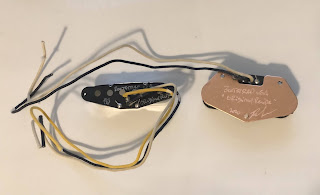I’ve owned a Roland Cube 60 modeling amp since 2004. I outgrew it once I started getting into playing though tube amps and VST amp modeling. I wanted to separate the amp into a head and cabinet so I could get more use out of the amp. Unfortunately I learned that the Cube 60 baffle cutout was too small for typical 12” speakers. The stock full range Roland Cube 12” speaker is a different shape than a typical 12” guitar speaker.
 |
| Roland Cube 60 Cabinet with Mojotone 12” to 10” Baffle Converter. |
I didn’t have a way to cleanly enlarge the hole in the baffle. The easiest option in my mind was to use the cabinet for a smaller 10” speaker. I ran across plywood baffle converters from J Design and Mojotone. I went with the Mojotone, since it was suited for front mounting of speakers. The Mojotone converter comes with 4 keps nuts to hold a 10” speaker onto the converter’s speaker mounting bolts. I bought some slightly longer M4x35mm bolts to mount the converter onto the Cube’s MDF baffle. The stock speaker mounting bolts are M4x25mm.
I will be trying out a Jensen C10Q and an Eminence GA10-SC64 in the cabinet. Based on my encouraging experiences with recording with the Jensen P10R speaker, I want to explore more flavors of 10" speakers with my 5F1/5F2A head and Pro Junior IV.
If the cabinet records well and I can make some useful impulse responses out of it, then I plan on buying some more 10" speakers to rotate in and out. I will keep the metal grille off, so the front loading of speakers should lead to quick speaker swaps. I am hoping that the front porting and the inside insulation will not significantly impact the sound negatively in a close mic'd scenario.
Edit - 6/11/21 - I loaded the Eminence GA10-SC64 into the cabinet. I finger tightened the keps nuts of the baffle to secure the speaker. I got the feeling that the baffle is actually meant for rear loaded installations, but will proceed with using it as a front loaded cabinet.
 |
| Cabinet front loaded with speaker. |
 |
| 2021 Eminence GA10-SC64 Speaker. |
 |
| Jensen C10Q. |
Edit - 06/25/21 - The GA10-SC64 is very different from the P10R. I am not familiar with the nuances of American-style speakers, since there aren’t as many online audio examples as the British-style speakers. The P10R works well with tweed overdrive, while the GA10-SC64 fares better with cleans for my usage. The GA10-SC64 is not harsh, even with a microphone pointed directly at the center of the dust cap. Blends of my GA10-SC64 and P10R IR captures are pleasing, as the speakers seem to be complementary.
 |
| Capturing GA10-SC64 IRs with a Shure SM57. |





